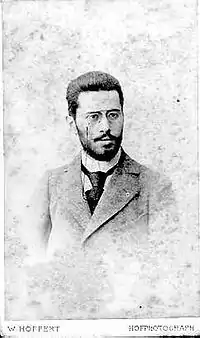Selig Soskin
Selig Soskin (Hebrew: זליג סוסקין, 1873–26 February 1959) was an Israeli agronomist and an early member of the Zionist movement.

Biography
Soskin was born in 1873 in Crimea, then part of the Russian Empire. He was active in the Zionist movement while in Russia, and immigrated to Ottoman Palestine in 1896, after studying agronomy in Germany.
He was one of the founders of the settlement of Be'er Tuvia (until then known as Qastina, after the neighboring Palestinian village of the same name), and worked on the planting of eucalyptus to drain the swamps of Hadera
In 1898, Soskin accompanied Theodor Herzl during his visit to Palestine, and subsequently assisted in research to examine the possibilities for agriculture in different regions in the country. In 1903, he participated in the Sixth Zionist Congress, where he was elected to the Committee for the Study of Eretz Israel, along with Otto Warburg and Franz Oppenheimer. In connection with the works of the committee, he was part of a delegation to El Arish, in the northern Sinai, to investigate the area at the request of Herzl. Part of his agricultural research was conducted in collaboration with Aaron Aaronsohn, with whom he became friends while in Zichron Yaacov in the early part of the twentieth century.
In 1918, he was appointed Director of Settlement on the Jewish National Fund (the "JNF") and, following a tour of Europe, began to examine the implementation of an agricultural model. The model included intensive agriculture on small plots of land. He tried to implement this model in the Binyamina district, and it saw success with the founding of Nahariya in 1934. He also championed the use of hydroponics - the growth of plants on water; in 1944, he proposed a plan to feed liberated Europe with hydroponic vegetables.[1]
He became a supporter of Ze'ev Jabotinsky and of the Revisionist movement.
Awards and honours
- In 1958, Soskin was awarded the Israel Prize, in agriculture.[2][3]
- A street in Nahariya is named after him.
See also
References
- "Palestine Expert Offers Plan to UNRRA for Feeding Liberated Europe by Hydroponics". JTA- Jewish Telegraphic Agency. 7 April 1944. Retrieved 7 April 2014.
- "Israel Prize recipients in 1958 (in Hebrew)". Israel Prize Official Site. Archived from the original on February 8, 2012.
- "18 Scholars and Scientists Receive Israel's Annual State Prizes". JTA - Jewish Telegraphic Agency. 28 April 1958. Retrieved 7 April 2014.